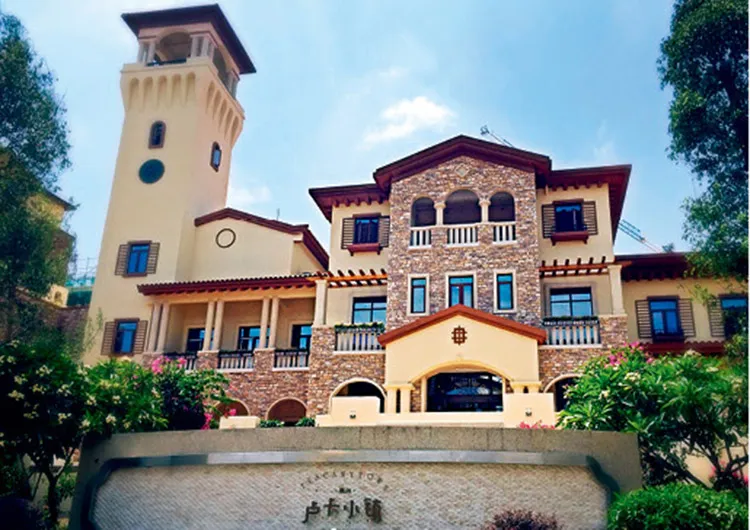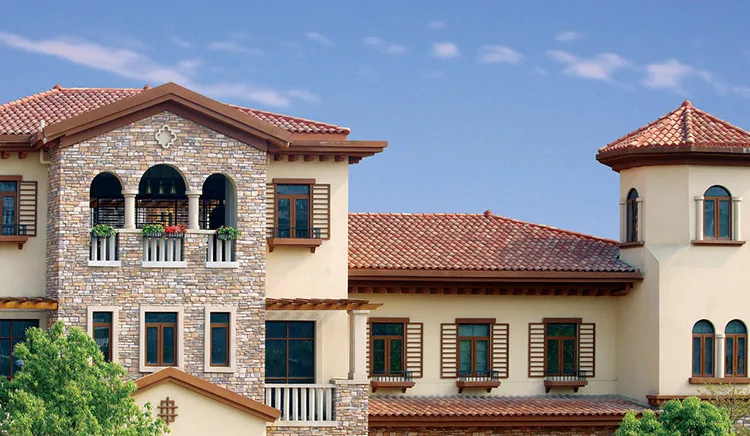Clay tile roofs have a long history in the field of construction and are favored for their durability, beauty and unique architectural style. Although the material of clay roof tiles itself is highly resistant to wind, UV rays and climate change, the correct fixing method is crucial to ensure its stability and long-term use on the roof. During roof construction, there are two main ways to fix clay tiles: using nails or using screws. Both methods have their own advantages and limitations in actual construction, but which one is more suitable for fixing clay roof tiles?
This article will explore the differences between nails and screws from multiple angles to help homeowners and construction workers make a more informed choice.

Fixing Clay Roof Tiles: Basic Differences Between Nails and Screws
Nails and screws are commonly used fasteners in construction and decoration. Although they have many similarities in function, they have significant differences in structure, strength, and usage scenarios.
1. Characteristics of Nails
A nail is a straight-shaped fastener whose basic design includes a sharp end and a flat head. During construction, nails are driven into wood, metal or other materials by external force (usually a hammer), and their stability is maintained by friction.
Advantages of nails:
● Quick installation: Nails are relatively simple and quick to install. They can be driven into the desired position using only a hammer or nail gun without complicated tools or a lot of time.
● Low material cost: Compared with screws, the production process of nails is relatively simple and the cost is relatively low. Especially in large-scale projects, the use of nails can significantly reduce the overall cost.
Disadvantages of nails:
● Weak tensile performance: The fixing principle of nails mainly relies on friction, so their pull-out resistance is relatively weak, especially under high stress or strong wind impact, nails may easily loosen or fall out.
● Not easy to remove: Once a nail is fixed in a certain position, it is easy to damage the surface of the material when it is removed, especially in wooden or brittle materials, and the removal of nails may cause damage to clay roof tiles or underlying materials.
2. Characteristics of screws
Compared with nails, screws have a threaded design, which is gradually screwed into the material by rotation. This design allows the screw to be more firmly embedded in the material when fixed and provides greater stability.
Advantages of screws:
● More secure fixation: Because the screw has threads, it can form a tighter connection inside the material, which makes the screw significantly better than nails in terms of pull-out resistance, vibration resistance and wind resistance.
● Reusable: Screws are easy to install and remove, and even when maintenance or replacement is required later, the removal of the screw usually does not cause much damage to the material, thereby maintaining the integrity of the material.
Disadvantages of screws:
● Slow installation: Screws are relatively slow to install and require specific tools (such as electric screwdrivers or wrenches), especially when installing on large roofs, using screws will take more time and effort.
● Higher cost: The production process of screws is more complicated than nails, so the price of screws is usually higher than that of nails. If screws are used to install roofs on a large scale, the material cost may increase significantly.

What are the standards for fixing clay tile roofs?
In order to better understand the advantages and disadvantages of nails and screws in the fixation of clay roof tiles, we need to first clarify the fixation requirements of clay tile roofs. Clay tiles are a heavy material, and their installation needs to consider not only the load-bearing capacity of the tiles, but also the following aspects:
1. Wind resistance: As the outermost structure of the building, the roof is exposed to the natural environment all year round and faces the impact of climate change such as wind, rain, and snow. Especially in areas with frequent typhoons or strong winds, the fixation of clay roof tiles must be able to withstand the pull and thrust of strong winds. A tile that is not firmly fixed may shift or even fall off in strong winds, which will not only cause damage to the roof, but also may cause safety hazards to the surrounding environment and pedestrians.
Therefore, the fixing method of clay roof tiles must have strong pull-out resistance to ensure that the clay roof tiles can remain in place under extreme weather conditions and protect the house from damage.
2. Load-bearing and earthquake resistance: Due to its heavy weight, the roof structure of clay roof tiles must be able to withstand long-term heavy pressure, especially in earthquake-prone areas, the roof needs to have a certain earthquake resistance. Although clay roof tiles themselves have good pressure resistance, when affected by earthquakes or other vibrations, the connection strength and fixing method between clay roof tiles are key factors.
In this case, the stability and durability of the fixings are particularly important. Loose or falling tiles will not only affect the waterproofness and overall aesthetics of the roof, but may also cause the clay roof tiles to fall, posing a threat to personal safety.
3. Waterproof function: An important function of a clay tile roof is to prevent rainwater from penetrating. In order to ensure the waterproof effect of the roof, the gaps between the clay roof tiles must be very tight to prevent rainwater from penetrating into the internal structure through the gaps. Therefore, the clay roof tiles must be fixed in a way that ensures that the clay roof tiles will not loosen or move when exposed to rain or humidity for a long time, otherwise the waterproof performance of the roof will be seriously affected.

What are the advantages and disadvantages of fixing clay tiles with nails?
Advantages of fixing clay tiles with nails
Nails still have their specific advantages in fixing clay tiles, especially when quick installation is required or cost-effectiveness is considered.
● Fast installation: Using nails to fix clay tiles is a relatively quick process. Construction workers can quickly drive nails into the roof substrate to complete the initial fixation of clay roof tiles. This fast installation feature is very suitable for large-area roof construction projects.
● Suitable for low-stress environments: In some areas with low wind speed and mild climate, using nails to fix clay roof tiles may be sufficient to provide sufficient stability. Although nails have poor pull-out resistance, in low-stress environments, the weight of the clay tiles themselves can help maintain stability, and nails mainly play an auxiliary fixing role.
Disadvantages of nailing clay tiles
Although nails perform well in some cases, their limitations are also obvious, especially when dealing with extreme weather and high-stress environments.
● Weak wind resistance: The fixing principle of nails relies on friction, so nails are prone to loosening or being pulled out in the face of strong winds or severe vibrations. For roofs exposed to strong winds, this may cause clay roof tiles to fall off, affecting the integrity and safety of the roof.
● Poor durability: Nails may gradually lose their fixing effect over time due to material fatigue or thermal expansion and contraction of the roof. Nails exposed to sunlight, rain and other natural environments for a long time are also prone to rust or corrosion problems, further reducing their fixing ability.
What are the advantages and disadvantages of fixing clay tiles with screws?
Advantages of screw-fixed clay tiles
The advantages of screws in fixing clay roof tiles are their superior stability and pull-out resistance.
● Stronger tensile resistance: Due to the threaded design of the screw, it can be more firmly embedded in the material when fixed, forming a tighter connection than nails. This allows the screw to withstand greater tension, especially in strong winds, earthquakes or other extreme conditions, the fixing performance of the screw is far better than nails.
● Stronger durability: Screws are usually made of anti-corrosion materials, such as stainless steel or galvanized steel, which allows the screws to maintain their fixing effect when exposed to moisture or extreme climates for a long time, reducing the risk of loosening due to rust or corrosion.
● Easy to maintain later: Screws can be easily screwed in during installation and are relatively easy to remove. This makes it easier to maintain or replace clay roof tiles fixed by screws in the future without causing too much damage to the clay roof tiles or substrate.
Disadvantages of screw-fixed clay tiles
Although screws have significant advantages, their cost of use and installation complexity cannot be ignored.
● Long installation time: Compared with nails, screws are slower to install and require power tools for fixing, which increases the complexity and time cost of construction. In large-scale roof installation projects, using screws to fix clay roof tiles may significantly extend the construction period.
● High material cost: The production process of screws is more complicated, and their material cost is also higher than that of nails. For projects with limited budgets, the high cost of screws may become a limiting factor.

Fixing clay roof tiles: How to choose the right method?
Nails and screws have their own advantages and disadvantages in fixing clay roof tiles. The choice of which fixing method should be determined according to the specific project requirements and external environment.
● If the project is located in an area with strong winds or frequent earthquakes, screw fixing is undoubtedly a better choice. Its strong tensile strength and durability can provide longer-term protection for the roof.
● If the project budget is limited and it is located in an area with relatively mild climate and low wind, using nails to fix may be a more economical choice. In this case, although the wind resistance of nails is not as good as that of screws, the weight of clay roof tiles and reasonable construction methods can effectively compensate for this defect.
Rongguan is one of the largest suppliers of quartz countertops, artificial marble, and clay roof tiles in South China. With state-of-the-art production facilities and high-quality materials, we offer customized solutions to meet the diverse needs of our clients. Our wholesale options come at discounted prices, ensuring that you get the best value for your purchase. Whether you need bulk orders or small-scale supplies, we provide competitive quotes and special promotions. Contact us today!

